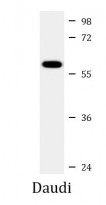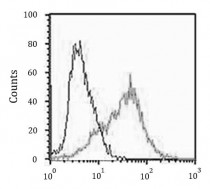ARG55213
anti-CHRNA9 antibody
anti-CHRNA9 antibody for Flow cytometry,Western blot and Human
Neuroscience antibody
Overview
| Product Description | Rabbit Polyclonal antibody recognizes CHRNA9 |
|---|---|
| Tested Reactivity | Hu |
| Tested Application | FACS, WB |
| Host | Rabbit |
| Clonality | Polyclonal |
| Isotype | IgG |
| Target Name | CHRNA9 |
| Antigen Species | Human |
| Immunogen | KLH-conjugated synthetic peptide corresponding to aa. 8-42 (N-terminus) of Human CHRNA9. |
| Conjugation | Un-conjugated |
| Alternate Names | Neuronal acetylcholine receptor subunit alpha-9; HSA243342; NACHRA9; Nicotinic acetylcholine receptor subunit alpha-9; NACHR alpha-9 |
Application Instructions
| Application Suggestion |
|
||||||
|---|---|---|---|---|---|---|---|
| Application Note | * The dilutions indicate recommended starting dilutions and the optimal dilutions or concentrations should be determined by the scientist. | ||||||
| Positive Control | Daudi |
Properties
| Form | Liquid |
|---|---|
| Purification | Purification with Protein A and immunogen peptide. |
| Buffer | PBS and 0.09% (W/V) Sodium azide |
| Preservative | 0.09% (W/V) Sodium azide |
| Storage Instruction | For continuous use, store undiluted antibody at 2-8°C for up to a week. For long-term storage, aliquot and store at -20°C or below. Storage in frost free freezers is not recommended. Avoid repeated freeze/thaw cycles. Suggest spin the vial prior to opening. The antibody solution should be gently mixed before use. |
| Note | For laboratory research only, not for drug, diagnostic or other use. |
Bioinformation
| Database Links |
Swiss-port # Q9UGM1 Human Neuronal acetylcholine receptor subunit alpha-9 |
|---|---|
| Gene Symbol | CHRNA9 |
| Gene Full Name | cholinergic receptor, nicotinic, alpha 9 (neuronal) |
| Background | This gene is a member of the ligand-gated ionic channel family and nicotinic acetylcholine receptor gene superfamily. It encodes a plasma membrane protein that forms homo- or hetero-oligomeric divalent cation channels. This protein is involved in cochlea hair cell development and is also expressed in the outer hair cells (OHCs) of the adult cochlea. [provided by RefSeq, Feb 2012] |
| Function | Ionotropic receptor with a probable role in the modulation of auditory stimuli. Agonist binding induces a conformation change that leads to the opening of an ion-conducting channel across the plasma membrane (PubMed:11752216, PubMed:25282151). The channel is permeable to a range of divalent cations including calcium, the influx of which may activate a potassium current which hyperpolarizes the cell membrane (PubMed:11752216, PubMed:25282151). In the ear, this may lead to a reduction in basilar membrane motion, altering the activity of auditory nerve fibers and reducing the range of dynamic hearing. This may protect against acoustic trauma. May also regulate keratinocyte adhesion (PubMed:11021840). [UniProt] |
| Cellular Localization | Cell junction, synapse, postsynaptic cell membrane; Multi-pass membrane protein Cell membrane; Multi-pass membrane protein |
| Research Area | Neuroscience antibody |
| Calculated MW | 55 kDa |
| PTM | N-glycosylated. |
Images (2) Click the Picture to Zoom In
-
ARG55213 anti-CHRNA9 antibody WB image
Western blot: 35 µg of Daudi cell lysate stained with ARG55213 anti-CHRNA9 antibody at 1:1000 dilution.
-
ARG55213 anti-CHRNA9 antibody FACS image
Flow Cytometry: Jurkat cells stained with ARG55213 anti-CHRNA9 antibody (right histogram) at 1:25 dilution or without primary antibodies (left histogram), followed by incubation with Alexa Fluor® 488 labelled secondary antibody.







